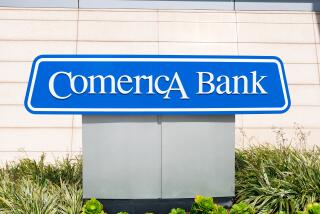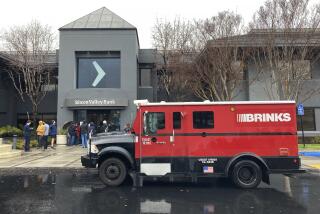S&Ls; Cut Losses Slightly in Third Quarter
- Share via
WASHINGTON — Despite the start of President Bush’s bailout plan, the savings and loan industry lost $3.8 billion in the July-September quarter, only slightly less than the record high set the previous quarter, the government said Thursday.
The loss at the nation’s 2,903 S&Ls;, including 256 under government control, was $261 million less than a record $4.1-billion loss reported for the second quarter, the Office of Thrift Supervision said.
For the year so far, losses total $11.5 billion, well on track to top the $13.4-billion loss for all of 1988, the post-Depression high.
Industry analysts said they saw little prospect for a return to profitability soon, despite the Aug. 9 enactment of Bush’s rescue plan, which calls for spending $50 billion through 1991.
“We still have as much as $20 billion in losses out there that haven’t come to the surface,” said Bert Ely, a financial institutions analyst in Alexandria, Va. “It’s like a water torture. It’s going to continue quarter after quarter after quarter.”
Ely estimated that third-quarter losses would have been about $1.6 billion greater if not for what amounts to a continuing government subsidy to 220 institutions rescued in 1988.
Also, as part of the Bush plan, the government poured $8.5 billion into thrifts under its control during the last half of the third quarter, paying off high-cost deposits. Although that reduced costs at those institutions, Ely said it probably did little to blunt total industry losses.
About two-thirds of the red ink, $2.6 billion, came in institutions already under government management and earmarked for liquidation or sale.
Thrift office economist James Freund noted that all but $275 million of the remaining $1.2-billion loss occurred at 223 institutions targeted for government takeover within the next year.
Freund said non-operating losses at S&Ls; outside government control jumped by $500 million, to $1.9 billion, because institutions sold assets to raise cash, recognizing losses in the process, in preparation for new more stringent capital standards that took effect Dec. 7.
Meanwhile, operating profits at the non-government thrifts slipped from $900 million to $800 million because of the recent pattern of interest rates, he said. Short-term rates paid on deposits are almost as high as long-term rates S&Ls; can earn on loans.
Private economists used the occasion of Thursday’s report to urge the government to pick up the pace of S&L; rescues. Only about 35 have been completed since the enactment of the Bush bill.
“I just don’t really see any hope of turning around the overall profit numbers . . . until we get these insolvent institutions out of the market,” said economist Catherine England of the Cato Institute, a conservative research organization.
“The faster we get the . . . depositors paid off and those institutions closed, the lower the ultimate cost of the cleanup is going to be and the sooner we’ll be able to turn around the marginal and healthy thrifts,” she said.
Until the government takes final action against the hundreds of still-open insolvent thrifts, management of those institutions will have every incentive to take big risks in the hope of staving off closure, said economist Edward Kane of Ohio State University.
“When you get desperate people doing desperate things, on average they tend to lose money,” he said.
Texas, as usual, recorded the biggest loss by any state, $998 million. However, that was an improvement from the $1.7-billion loss a year ago. The second-biggest loss came in Arizona, with $443 million; followed by California, $426 million, Pennsylvania, $322 million, and Arkansas, $246 million.
More to Read
Inside the business of entertainment
The Wide Shot brings you news, analysis and insights on everything from streaming wars to production — and what it all means for the future.
You may occasionally receive promotional content from the Los Angeles Times.










